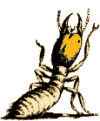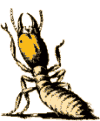 INSPECTION & REPORT a thorough inspection the buildings and surrounds INSPECTION & REPORT a thorough inspection the buildings and surrounds
 CHEMICAL SOIL BARRIER TREATMENT at the base of a building or structure CHEMICAL SOIL BARRIER TREATMENT at the base of a building or structure
 TERMITE BAITING-COLONY ELIMINATION installation and monitoring TERMITE BAITING-COLONY ELIMINATION installation and monitoring
 TERMITE NEST LOCATION & ERADICATION as found in trees / stumps TERMITE NEST LOCATION & ERADICATION as found in trees / stumps
 BUILDING MODIFICATIONS & MAINTENANCE termite risk reduction advice BUILDING MODIFICATIONS & MAINTENANCE termite risk reduction advice
 BORATE CHEMICAL TREATMENT of readily accessible structural timbers BORATE CHEMICAL TREATMENT of readily accessible structural timbers
 FOLLOW-UP INSPECTIONS and building maintenance recommendations FOLLOW-UP INSPECTIONS and building maintenance recommendations
 HOME-BUILDERS physical barriers / other devices, during construction HOME-BUILDERS physical barriers / other devices, during construction
| Initial Inspection of Buildings & Surrounds |

 Firstly, it is essential for the termite controller to complete a thorough inspection of the buildings and surrounds, in accordance with the Australian Standard 3660. Firstly, it is essential for the termite controller to complete a thorough inspection of the buildings and surrounds, in accordance with the Australian Standard 3660.
 AS 3660 requires the property owner to be supplied with a written inspection report and detailed specifications for an integrated termite control program. It is a legal requirement that such an inspection and report be carried out prior to a chemical soil treatment, and only a licensed pest controller may apply the chemical soil treatment. AS 3660 requires the property owner to be supplied with a written inspection report and detailed specifications for an integrated termite control program. It is a legal requirement that such an inspection and report be carried out prior to a chemical soil treatment, and only a licensed pest controller may apply the chemical soil treatment.
 The cost of a termite inspection report and quotation / treatment recommendations is usually around $150 to $250, for an average size dwelling. Some companies offer a "free inspection" but only examine the external areas and build the cost into their quotation / treatment proposals. The cost of a termite inspection report and quotation / treatment recommendations is usually around $150 to $250, for an average size dwelling. Some companies offer a "free inspection" but only examine the external areas and build the cost into their quotation / treatment proposals.
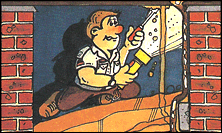 |
A professional termite inspection and report could save you thousands of dollars - specific areas inspected include accessible timbers within the sub-floor, roof void, exterior and interior of the building and other timber structures, fences and trees within a 50 metre radius of the buildings but within the property boundary. |
| Chemical Soil Barrier Treatments
|

 CONSUMER NOTE: Most home-owners are unaware that their general home insurance policy does NOT cover termite damage to structural timbers. However, appropriate professional indemnity insurance is available to some companies to cover termite damage to structural timbers in a building caused by termites gaining entry into a building through a chemical soil barrier. CONSUMER NOTE: Most home-owners are unaware that their general home insurance policy does NOT cover termite damage to structural timbers. However, appropriate professional indemnity insurance is available to some companies to cover termite damage to structural timbers in a building caused by termites gaining entry into a building through a chemical soil barrier.
 The chemical soil barrier involves treating the soil at the base of a building with a registered termiticide chemical, in accordance with the product label, that will prevent termites travelling through that soil to get to the timbers of the protected structure above. The chemical soil barrier involves treating the soil at the base of a building with a registered termiticide chemical, in accordance with the product label, that will prevent termites travelling through that soil to get to the timbers of the protected structure above.
 If there are termites in the building, at the time of chemical soil treatment, they cannot safely return to their central colony nest through the chemically treated soil. Termites are compelled to regularly return to their central colony nest in the ground to obtain moisture essential for their survival and to feed and groom the nymphs (young termites), the king, queen and other termites. If there are termites in the building, at the time of chemical soil treatment, they cannot safely return to their central colony nest through the chemically treated soil. Termites are compelled to regularly return to their central colony nest in the ground to obtain moisture essential for their survival and to feed and groom the nymphs (young termites), the king, queen and other termites.
 The installation of a chemical soil barrier requires expert knowledge and specialised equipment to form a complete and continuous barrier to protect the building from a termite entry and infestation - as illustrated below:
The installation of a chemical soil barrier requires expert knowledge and specialised equipment to form a complete and continuous barrier to protect the building from a termite entry and infestation - as illustrated below:
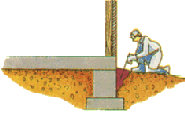
|

|
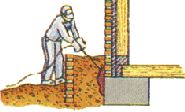
|
| Trench and treat soil around external concrete slab edge -
a common termite entry point |
Trench and treat soil around walls and piers in the sub-floor area |
Use rod injection to treat soil along and around the external perimeter area of the building |
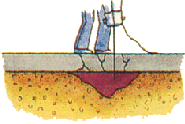
|
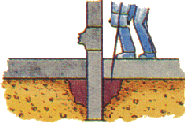
|
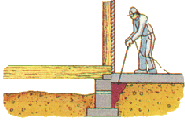
|
| Drill concrete floor along all expansion joints and cracks, and treat soil thereunder |
Drill concrete floor around pipes and treat soil thereunder
|
Drill concrete patio areas and treat soil area therein - a high risk termite nest location |
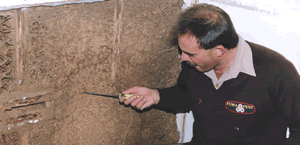
|
PLEASE NOTE: Special care needs to be taken to ensure a subsidiary termite nest is NOT contained within the building. Usually occurs wall cavities with a moisture problem, say from a leaking shower recess, broken roof tiles, faulty guttering or plumbing. A treated soil barrier will trap these termites inside the building where they may survive for years.
|
|
PESTICIDE SAFETY ISSUES - Soil Barrier Chemicals
|

There are FOUR chemicals registered by the relevant Federal Government - National Registration Authority for use in termite control as a soil treatment chemical, namely;
 |
chlorpyrifos........trade name Dursban and Deter,
bifenthrin............trade name Biflex
imidacloprid........trade name Premise
fipronil ................trade name Termidor - a new product
|
WARNING: Both Dursban (chlorpyrifos) and Biflex (bifenthrin) are solvent based pesticides which can cause health problems to asthmatics during the drying process. Both Dursban and Biflex are Schedule 6 insecticide - with POISON on the registered label.
 Termidor and Premise are water based, odourless and of low hazard to humans, dogs, cats and other mammals. Both are registered as a low hazard Schedule 5 insecticide with a CAUTION notation on the registered label. In fact, fipronil (Termidor) has been used in the USA and Australia for many years for flea and tick control on millions of cats and dogs. Fipronil is contained in some of the ant control bait products you can buy in Woolworths and other such outlets. Termidor and Premise are water based, odourless and of low hazard to humans, dogs, cats and other mammals. Both are registered as a low hazard Schedule 5 insecticide with a CAUTION notation on the registered label. In fact, fipronil (Termidor) has been used in the USA and Australia for many years for flea and tick control on millions of cats and dogs. Fipronil is contained in some of the ant control bait products you can buy in Woolworths and other such outlets.
 Termidor and Premise do NOT have an obnoxious odour or emit airborne residues or fumes. Termidor and Premise represent modern technology... they are NOT organo-chlorine or organo-phosphate pesticides. Termidor and Premise do NOT have an obnoxious odour or emit airborne residues or fumes. Termidor and Premise represent modern technology... they are NOT organo-chlorine or organo-phosphate pesticides.
 Dursban and Biflex have a strong repellancy action to deter foraging termites. Whereas Termidor and Premise are non-repellant to the termites. Termites can enter the treated soil barrier without detecting the Termidor or Premise chemical. The repellant nature of Dursban and Biflex mean the termites can detect and move along the soil barrier seeking a gap to gain entry into the building. Dursban and Biflex have a strong repellancy action to deter foraging termites. Whereas Termidor and Premise are non-repellant to the termites. Termites can enter the treated soil barrier without detecting the Termidor or Premise chemical. The repellant nature of Dursban and Biflex mean the termites can detect and move along the soil barrier seeking a gap to gain entry into the building.
 Premise has been used as soil treatment barrier against termites for more than six years in Australia (more than eight years in the USA) with excellent results for long term termite control. We are not aware of any significant problems during this period. Premise has been used as soil treatment barrier against termites for more than six years in Australia (more than eight years in the USA) with excellent results for long term termite control. We are not aware of any significant problems during this period.
 Termidor and Premise kill termites, even in soil areas of lower dose rates. With Premise, some of the termites that are not killed on contact with a concentrated chemically treated soil area, will become disorientated, stop feeding, and are fatally diseased by natural fungi and micro-organisms in the soil. Termidor and Premise kill termites, even in soil areas of lower dose rates. With Premise, some of the termites that are not killed on contact with a concentrated chemically treated soil area, will become disorientated, stop feeding, and are fatally diseased by natural fungi and micro-organisms in the soil.
 Termidor is registered for application as a chemical soil barrier to buildings, fences, stumps and posts. Termidor will kill termites foraging in the treated soil area. However what's unique about Termidor is it's effect on the termite colony. The fipronil chemical attaches to the exoskeleton of the foraging termites ... it's delayed lethal effect is designed to provide time for the chemical to be transferred back to the central colony nest, where it is unknowingly spread to the other termites by the regular feeding and grooming of each other. Termidor is registered for application as a chemical soil barrier to buildings, fences, stumps and posts. Termidor will kill termites foraging in the treated soil area. However what's unique about Termidor is it's effect on the termite colony. The fipronil chemical attaches to the exoskeleton of the foraging termites ... it's delayed lethal effect is designed to provide time for the chemical to be transferred back to the central colony nest, where it is unknowingly spread to the other termites by the regular feeding and grooming of each other.
 It appears Termidor in cases of a severe infestation, usually takes several weeks to stop the termites in their tracks. In our opinion, based upon a range of attributes, Termidor is the top of the range "stand-alone" product in most circumstances to protect a building under attack from subterranean termites. It appears Termidor in cases of a severe infestation, usually takes several weeks to stop the termites in their tracks. In our opinion, based upon a range of attributes, Termidor is the top of the range "stand-alone" product in most circumstances to protect a building under attack from subterranean termites.
 Termidor has been used in more than 600,000 homes the USA and field tested extensively in Australia. Termidor was approved in November 2002 for use against Australian destructive termite species.
CLICK HERE for further details on Termidor Termidor has been used in more than 600,000 homes the USA and field tested extensively in Australia. Termidor was approved in November 2002 for use against Australian destructive termite species.
CLICK HERE for further details on Termidor
|
Termite Colony Elimination - Termite Baits in Australia |

 Australian pest controllers have used arsenic dusting of live termites since about 1920. This involves puffing a light covering of the arsenic dust inside the galleries (mud-tubes) and workings of the termites. Termite colony elimination may occur if a sufficient quantity of the arsenic toxicant gets back to the central colony nest. Arsenic dusting is too unreliable compared to the alternatives. The main short-coming of arsenic dusting is it is a highly toxic compound that can kill termites on contact and so they can detect and avoid that location, giving the property owner a false sense of security. The termites can enter the building through other locations, causing significant damage before detection.
Australian pest controllers have used arsenic dusting of live termites since about 1920. This involves puffing a light covering of the arsenic dust inside the galleries (mud-tubes) and workings of the termites. Termite colony elimination may occur if a sufficient quantity of the arsenic toxicant gets back to the central colony nest. Arsenic dusting is too unreliable compared to the alternatives. The main short-coming of arsenic dusting is it is a highly toxic compound that can kill termites on contact and so they can detect and avoid that location, giving the property owner a false sense of security. The termites can enter the building through other locations, causing significant damage before detection.
 The Sentricon Termite Colony elimination system was registered in July 1997 by Dow AgroSciences. The Sentricon bait is hexaflumuron, an insect growth regulator, which is designed to be spread throughout the colony by the worker termites. One significant difference, is that Intrigue termite dust is 80% concentrated chemical, whereas the Sentricon bait is only 0.5% concentrate, due to repellency problems with the Sentricon bait used at higher dosage rates. The Sentricon Termite Colony elimination system was registered in July 1997 by Dow AgroSciences. The Sentricon bait is hexaflumuron, an insect growth regulator, which is designed to be spread throughout the colony by the worker termites. One significant difference, is that Intrigue termite dust is 80% concentrated chemical, whereas the Sentricon bait is only 0.5% concentrate, due to repellency problems with the Sentricon bait used at higher dosage rates.
 Intrigue termite dust, was introduced by Bayer in April 2000 into the Australian market, with many pest controllers using timber boxes designed to accumulate large numbers of foraging termites near high activity points. Intrigue dust contains triflumuron, an insect growth regulator, which is non-repellant to the termites. However, Intrigue being a dust is not an ideal product, as most termite activity areas are usually moist and the Intrigue dust will coagulate in such areas. Intrigue termite dust, was introduced by Bayer in April 2000 into the Australian market, with many pest controllers using timber boxes designed to accumulate large numbers of foraging termites near high activity points. Intrigue dust contains triflumuron, an insect growth regulator, which is non-repellant to the termites. However, Intrigue being a dust is not an ideal product, as most termite activity areas are usually moist and the Intrigue dust will coagulate in such areas.
 An insect growth regulator affects termites by stopping the moulting process required for the termites to grow. As the worker termites die off, the termite colony declines to the point where it can no longer sustain itself, ultimately leading to it's collapse and elimination. An insect growth regulator affects termites by stopping the moulting process required for the termites to grow. As the worker termites die off, the termite colony declines to the point where it can no longer sustain itself, ultimately leading to it's collapse and elimination.
 The Exterra Termite Colony elimination system was introduced in July 2002 by Ensystex into the Australian market. The Exterra termite bait, chlorfluazuron, is also an insect growth regulator. The Exterra Termite Colony elimination system was introduced in July 2002 by Ensystex into the Australian market. The Exterra termite bait, chlorfluazuron, is also an insect growth regulator.
 Both Sentricon and Exterra systems have their own plastic bait stations which must be used with their product. These bait stations can also act as monitoring stations, even after a successful termite colony elimination, to guard against other termite colonies in the area. Both Sentricon and Exterra systems have their own plastic bait stations which must be used with their product. These bait stations can also act as monitoring stations, even after a successful termite colony elimination, to guard against other termite colonies in the area.
 Termite colony elimination in favourable circumstances may take several weeks to a few months. However, in some cases, termite colony elimination is unsuccessful or may take years, depending on the circumstances. Where a large number of termites find and consume the bait, then colony elimination is virtually assured within a few months. This is where the experience and skill of the termite controller is paramount to decide if and where a baiting program is implemented and properly monitored. Termite colony elimination in favourable circumstances may take several weeks to a few months. However, in some cases, termite colony elimination is unsuccessful or may take years, depending on the circumstances. Where a large number of termites find and consume the bait, then colony elimination is virtually assured within a few months. This is where the experience and skill of the termite controller is paramount to decide if and where a baiting program is implemented and properly monitored.
 Both the Sentricon and Exterra termite baits are designed to be slow acting, non-repellant and therefore spread to other termites in the colony before they can notice the deadly effect or where it is coming from. Termites have acute survival instincts. A toxic food source detected will be abandoned. Too much disturbance of the foraging termites (workers and soldiers) in an area, will alert the termites to abandon the area. The termites appear to be gone, but may in fact be entering the building in other areas. Your home is a much bigger bait station. Both the Sentricon and Exterra termite baits are designed to be slow acting, non-repellant and therefore spread to other termites in the colony before they can notice the deadly effect or where it is coming from. Termites have acute survival instincts. A toxic food source detected will be abandoned. Too much disturbance of the foraging termites (workers and soldiers) in an area, will alert the termites to abandon the area. The termites appear to be gone, but may in fact be entering the building in other areas. Your home is a much bigger bait station.
 How safe are these products ? Intrigue termite dust is classified as a schedule 5 insecticide with a CAUTION notation on the registered label - indicating it is of low hazard to people, dogs, cats and other mammals. Exterra and Sentricon termite baits are not scheduled as hazardous products. How safe are these products ? Intrigue termite dust is classified as a schedule 5 insecticide with a CAUTION notation on the registered label - indicating it is of low hazard to people, dogs, cats and other mammals. Exterra and Sentricon termite baits are not scheduled as hazardous products.
 All the above termite baiting methods should be subject to regular inspection and monitoring by the termite controller. The larger the number of termites that consume the bait, the quicker and more certain is the termite colony elimination process. It is usual to reinspect the bait stations and the buildings and surrounds every month to reposition, reapply or replenish the bait, if neccessary. All the above termite baiting methods should be subject to regular inspection and monitoring by the termite controller. The larger the number of termites that consume the bait, the quicker and more certain is the termite colony elimination process. It is usual to reinspect the bait stations and the buildings and surrounds every month to reposition, reapply or replenish the bait, if neccessary.
 A termite baiting program can be integrated with a range of methods including drilling susceptible trees and eradication of any termite nest located therein. In addition, a chemical soil barrier to Australian Standard 3660 using Termidor or Premise soil treatment chemical at the base of a building or other structures is also recommended in high risk termite areas. A termite baiting program can be integrated with a range of methods including drilling susceptible trees and eradication of any termite nest located therein. In addition, a chemical soil barrier to Australian Standard 3660 using Termidor or Premise soil treatment chemical at the base of a building or other structures is also recommended in high risk termite areas.

|
Ring the Experts: The termite bait stations contain a timber food source for foraging termites, and are positioned in areas judged by the termite specialist to be areas conducive to termite activity. This requires expert skill and judgement, based upon years of field-work experience in termite control. Remember the chances of successful termite control depends on the skill and judgement of the termite controller to determine if where and when the appropriate products are to be installed and monitored.
|
CONSUMER PROTECTION NOTICE:
Be wary of any advertising or promise that a timber replacement warranty applies as regards subsequent termite damage to a building using a termite colony elimination system.
For example, some pest control companies promote a $100,000 Timber Replacement Warranty as regards to the use of the Sentricon Termite Colony Elimination System - BUT BE CAREFUL to read any proposed Service Contract carefully! Does this contract then specify that any such warranty may (or may not) apply at some future point in time as determined by the company?
As with all termite colony elimination systems there can be no absolute guarantee of protection of nearby buildings. There may be other termite nests nearby the building that do not find the bait stations. Your home is a much bigger bait station. Other termite nests may exist in trees, under concrete on-ground flooring and in-fill patios of your home or neighbouring properties.
|

EXTERRA - Click Here
|
 Intrigue termite dust can be applied directly to live termites in their mud tube galleries or infested timbers, whereas the Sentricon baits are placed in their in-ground bait stations after removal of the termite infested timber therein... which involves major disruption of the termites and thereby cause them to avoid the in-ground Sentricon bait station, entirely. Intrigue termite dust can be applied directly to live termites in their mud tube galleries or infested timbers, whereas the Sentricon baits are placed in their in-ground bait stations after removal of the termite infested timber therein... which involves major disruption of the termites and thereby cause them to avoid the in-ground Sentricon bait station, entirely.
 Sentricon was developed for use against American termites, a different species that are not as disturbance wary as some of the destructive Australian termite species. This serious short-coming is overcome by the patented Exterra Termite Stations where the timber is aligned around the cylinder such that the bait can be inserted without such disturbance of the termites present. Sentricon was developed for use against American termites, a different species that are not as disturbance wary as some of the destructive Australian termite species. This serious short-coming is overcome by the patented Exterra Termite Stations where the timber is aligned around the cylinder such that the bait can be inserted without such disturbance of the termites present.
|
 |
 RECOMMENDED PRODUCTS include the Intrigue dusting of live termites found and/or use of the Exterra termite control baiting system, where a complete chemical soil barrier treatment using Termidor or Premise is not practicable or desired, and where a sufficiently large number of live termites feed on the Intrigue or Exterra termite bait. RECOMMENDED PRODUCTS include the Intrigue dusting of live termites found and/or use of the Exterra termite control baiting system, where a complete chemical soil barrier treatment using Termidor or Premise is not practicable or desired, and where a sufficiently large number of live termites feed on the Intrigue or Exterra termite bait.
|
| Termite Colony Nest Location in Trees |

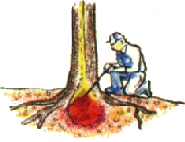
|
Subterranean termites commonly build their nests at the base of a well established eucalyptus or other susceptible trees.
We recommend the test drilling of all susceptible trees, located within a 50m radius and within the property boundary. If termites are located therein, a long thermometer is inserted into the tree trunk to determine if the central colony nest has been penetrated. |
 We also recommend Intrigue termite dust or Premise liquid termiticide be injected through the drill holes to eliminate any termite nest located therein. A tree sealant is then inserted into the drill holes to ensure the tree remains healthy. These chemicals will not harm the tree. We also recommend Intrigue termite dust or Premise liquid termiticide be injected through the drill holes to eliminate any termite nest located therein. A tree sealant is then inserted into the drill holes to ensure the tree remains healthy. These chemicals will not harm the tree.
 CONSUMER NOTE: With termite nest location and colony elimination, there can be no guarantee of certain protection of nearby buildings, as there may be other unlocated hidden termite nests near your property, for example, in trees on neighbouring properties that cannot be accessed. There also maybe a termite nest located under concrete slab flooring or within enclosed patios of your property or your neighbouring property. CONSUMER NOTE: With termite nest location and colony elimination, there can be no guarantee of certain protection of nearby buildings, as there may be other unlocated hidden termite nests near your property, for example, in trees on neighbouring properties that cannot be accessed. There also maybe a termite nest located under concrete slab flooring or within enclosed patios of your property or your neighbouring property.
|
Building Modifications & Maintenance
|

 Rapid termite colony development and building infestation is usually associated with a readily available food and moisture source near by the central nest. Buildings are often constructed in a way that encourages termite infestation and colony development, and allows termites to gain undetectable entry from the soil to the structural timbers of the building. Rapid termite colony development and building infestation is usually associated with a readily available food and moisture source near by the central nest. Buildings are often constructed in a way that encourages termite infestation and colony development, and allows termites to gain undetectable entry from the soil to the structural timbers of the building.
Therefore, it is essential for the home owner to carry out the following building modifications and maintenance to help reduce the risk of termite activity around a building.
 Moisture exclusion from inside the building, under suspended floors and around the base of the building. This may include improving cross flow ventilation in sub-floor area. A qualified plumber should be engaged to ensure there is no water leakage from plumbing pipes in the bathroom, the shower recess, kitchen, down pipes, guttering and air conditioning unit overflow. Water run-off should be excluded from the subfloor area by the installation of ag-drains. Moisture exclusion from inside the building, under suspended floors and around the base of the building. This may include improving cross flow ventilation in sub-floor area. A qualified plumber should be engaged to ensure there is no water leakage from plumbing pipes in the bathroom, the shower recess, kitchen, down pipes, guttering and air conditioning unit overflow. Water run-off should be excluded from the subfloor area by the installation of ag-drains.
 Removal of any timber in contact with the soil. Timbers should be stored above ground to allow full inspection of subterranean termite activity (coming from the soil thereunder). Any landscaping using timber chip mulch and railway sleepers should definitely be removed, as they provide ready food source to assist in rapid termite colony development. Removal of any timber in contact with the soil. Timbers should be stored above ground to allow full inspection of subterranean termite activity (coming from the soil thereunder). Any landscaping using timber chip mulch and railway sleepers should definitely be removed, as they provide ready food source to assist in rapid termite colony development.
 Inspection access to enable where ever practicable that unimpeded inspection of sub-floor (suspended floors) can be carried out to look for evidence of termite activity; also make sure if you have a concrete slab on ground flooring that you can inspect the entire external slab edge for evidence of termite mud-shelter tubes (do not allow this area to be covered by pavers, landscaping, etc. Inspection access to enable where ever practicable that unimpeded inspection of sub-floor (suspended floors) can be carried out to look for evidence of termite activity; also make sure if you have a concrete slab on ground flooring that you can inspect the entire external slab edge for evidence of termite mud-shelter tubes (do not allow this area to be covered by pavers, landscaping, etc.
 If you find live termites or termite affected workings DO NOT disturb the area as the termite controller can introduce Intrigue termite dust or Exterra termite bait to the live termites present in an attempt to eliminate the termite colony. If sufficiently disturbed, the termites are likely to move elsewhere, and may not be rediscovered until further obvious damage has been done. If you find live termites or termite affected workings DO NOT disturb the area as the termite controller can introduce Intrigue termite dust or Exterra termite bait to the live termites present in an attempt to eliminate the termite colony. If sufficiently disturbed, the termites are likely to move elsewhere, and may not be rediscovered until further obvious damage has been done.
|
Application of Borate Chemical Treatment to Accessible Timbers
|

 The direct application of Boracol, a borate chemical formulation to accessible timbers can prevent termite attack to the treated timbers. Boracol is designed to penetrate inside most building timbers. Life expectancy can be in excess of 20 years. Boracol also prevents fungal wood decay, borer attack and has some fire retardant properties. Boracol is less toxic than common salt to humans, dogs cats and other mammals. The direct application of Boracol, a borate chemical formulation to accessible timbers can prevent termite attack to the treated timbers. Boracol is designed to penetrate inside most building timbers. Life expectancy can be in excess of 20 years. Boracol also prevents fungal wood decay, borer attack and has some fire retardant properties. Boracol is less toxic than common salt to humans, dogs cats and other mammals.
 This application of Boracol is highly recommended (1) to timbers during construction, and (2) to existing buildings in situations where a complete chemical barrier cannot be installed, such as, the sub-floor and void timbers of attached terraces or duplexes. This application of Boracol is highly recommended (1) to timbers during construction, and (2) to existing buildings in situations where a complete chemical barrier cannot be installed, such as, the sub-floor and void timbers of attached terraces or duplexes.
|
Regular follow-up inspections / monitoring is essential !
|

 |
Australian Standard 3660 states "the installation of a chemical soil barrier does not negate the need for regular competent inspections - at intervals of 3 to 6 months where the termite risk is high".
We usually recommend 3 monthly inspections be carried for the first 12 months following a chemical soil treatment. |
|
Home Builders - Termite Control Products
|

|
